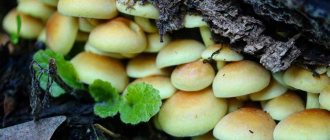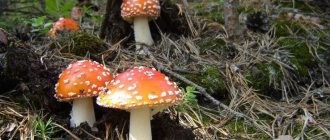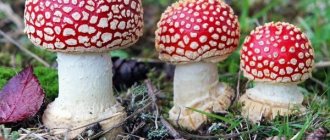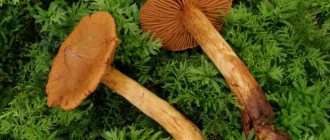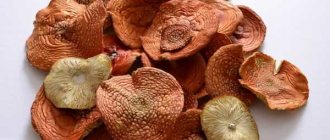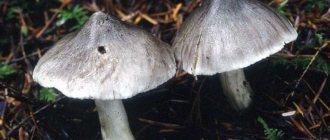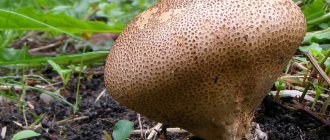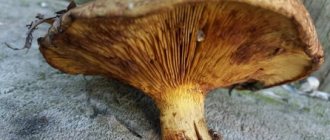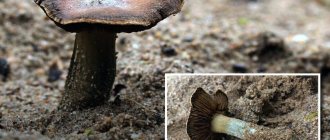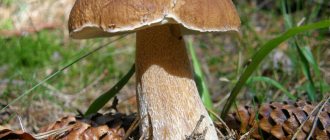Fiber is a poisonous mushroom of the arachnoid family. This mushroom acquired this name because of its fibrous stem. In its toxicity, the fly agaric is superior to the fly agaric: some of its species contain 20 times more muscarine than the red fly agaric.
These mushrooms, especially the young ones, are very similar to edible mushrooms. The danger of these mushrooms is compounded by the fact that they grow in the same places as edible mushrooms (champignons, ring caps). Inexperienced mushroom pickers can also confuse the fiberweed with entolomas or May row (May mushroom).
Types of fibers
Fiberwort is a very common genus of poisonous and hallucinogenic mushrooms. This genus includes about 150 species, of which more than a hundred grow in Russia. The most common types are: Patuillara, torn, earthy, fibrous and bluish-green.
Patouillard fiberglass
Content:
- Types of fibers
- How to distinguish
- Chemical composition
- Mushroom danger
- Signs of poisoning
- Help with poisoning
- conclusions
These are the most poisonous mushrooms of the genus fibre. They have caps 3-9 cm in diameter. Its shape differs in mushrooms of different degrees of maturity: in young ones it is cone-shaped, in ripe ones it is flat with a tubercle in the center. The reddish cap is smooth, with deep radial cracks along its edge. The plates on the back of the cap are very thick; in young specimens they are colored pink, in mature specimens they are brown with red spots. Spore powder is bright orange.
The stalk of the Patouillard fiber is cylindrical, dense, fibrous, and has a thickening at the base.
The flesh of young mushrooms is white; as it ripens, it turns red. The pulp has no smell, the taste is peppery. It contains a huge amount of poisonous muscarine.
These mushrooms grow in small groups in forests, parks, and gardens with clay and limestone soils. They bear fruit in August-September.
Torn fiberglass
This species is distinguished by its small size: their bell-shaped cap has a diameter of 2 to 5 cm. The top of the cap is covered with small scales, painted in different shades of brown, with flake-like fringe along the edges. On the underside of the cap there are brown plates with a white edge. Spore powder is rusty in color.
The leg is straight, brown, covered with reddish scales.
The flesh of the cap is white, and the flesh of the stem is red. The smell of the pulp is weak, and the taste is initially sweet, then bitter. The consumption of these mushrooms is strictly prohibited, as they are deadly poisonous.
They grow everywhere in damp forests. They bear fruit in July-September.
Fiber fiber earthen
These are small poisonous mushrooms. The cap of this type of fiber has a diameter of 2-3 cm, is hemispherical, and along the edges the remains of a private cover in the form of a thin cobweb are visible. The surface of the cap is white with a slight purple tint. The plates on the reverse side of the cap are loose and yellowish in color.
The stem of the mushroom is thin, silky, brown or brown in color. The pulp has an unpleasant odor. It contains a lot of the neurotoxic poison muscarine.
They grow singly or in small groups, in forests, parks, gardens, hiding in thickets of bushes or tall grass. Ripen in July-September.
Fiber fiber
These poisonous mushrooms are medium in size - the diameter of the cap is 6-8 cm. The cap has a cone-shaped shape with a wavy edge, dirty yellow or brown. Its surface is covered with radial cracks. On the underside of the cap there are white or brown plates with jagged edges.
The pulp is elastic, white-yellow on the cap and brown on the stem. The pulp contains the neurotoxic poison muscarine and the psychotropic substance psilocybin.
The stem is brown, about 10 cm high, covered with fibers. It is thickened at the base and forms a tuber in the ground.
They grow in coniferous and deciduous forests, in clearings with sparse herbaceous vegetation. Only single specimens are found.
Fiberglass bluish-green
The caps of mushrooms of this species do not exceed 4-5 cm in diameter. The surface of the caps is silky, smooth, rusty in color with a green tint. In young ones they are cone-shaped, flattening during maturation, but a tubercle remains in the center. The caps of mature individuals crack along the edges. There are grey-brown plates on the underside.
The flesh is white, the lower part of the stem is green-blue, which gives this species its name. The mushroom smells like toilet soap. It contains many different psychotropic (hallucinogenic) substances, the main of which is psilocybin.
The legs are smooth, thickened at the base, without an earthen tuber, covered in the upper part with powdery coating and fibers.
They grow everywhere in soils with a lot of sand and form mycorrhizae with deciduous trees. Often found in parks. They bear fruit from June to October.
Blue-green fiberweed is a conditionally inedible mushroom. Mushrooms of this species do not cause poisoning similar to poisoning from other types of fibers, but when they are consumed, auditory and visual hallucinations and a state of euphoria occur.
Habitat
- Patouillard fiber lives in European and Asian countries. Loves soils with a high lime content. Habitats: parks, hills, mountains, mixed and coniferous forests. It begins to bear fruit in May and until the end of October.
- Blue-green fibergrass is common in moist sandy soils and can even grow on sand. Mycorrhiza most often forms with birch, oak, aspen and willow. Prefers cultural landscapes and can be found in parks and gardens.
- The torn fiber is an inhabitant of damp places, found along roadsides and the edges of ditches, loves sandy soils and mountainous terrain. Often settles in coniferous and deciduous forests.
- Fiberwort prefers to grow in forests of any type, and is also found near the edges of roads.
- Acute fiberwort is one of the rarest species that can be found in Europe and Eastern Siberia. Can be found among conifers, in wetlands and sphagnum mosses.
- Fiberwort prefers a solitary existence among conifers, where there are no strong grass thickets.
How to distinguish
In order not to make mistakes when picking mushrooms, before putting them in a basket, you need to carefully study the structure:
- The cap of the fiber most often has the shape of a bell or cone with a sharp tubercle, and is covered with a fibrous shell on top. As the mushroom grows, radial cracks appear on the cap.
- On the underside of the cap there are yellowish or brownish-brown plates.
- The leg expands towards the base, is soft to the touch, covered with scales and fibers.
- The flesh of the mushroom is whitish or yellowish and most often has an unpleasant odor.
- The spores are a brown-brown powder.
Different types of fibers have distinctive features.
False doubles
Fiberwort, fortunately, is almost impossible to confuse with any edible or semi-edible species. There is only a distant resemblance to champignons and the so-called May mushrooms.
What they have in common are the color and shape of the cap, as well as the time and territory of growth, but even an ordinary person will not have difficulty distinguishing them just by comparing photographs.
Champignon May mushroom
The earthen fiber has a clear resemblance to its poisonous counterparts. For example, its white subspecies can be confused with pure Mycena (Mycena Pura).
The main differences of the latter are the moist grayish-brown cap with a clearly defined grooved edge, a hollow stem and a distinct radish odor.
Mycena pure
It is even easier to distinguish fiber by its rare reddish plates. There is also some possibility of confusing inocybe geophylla and cortinarius rubellus (known as the “beautiful cobweb”), since these mushrooms are similar in the shape of the cap, however, at the first glance at a photograph of the cobweb, a fundamental difference is noticeable - its rather bright red color.
Inocybe geophylla
REFERENCE! False twins of the earthen fiber are just as dangerous as the original, so it’s worth knowing what they look like.
Chemical composition
The pulp of the fiber contains many neurotoxic substances - muscarine and psilocybin. In different types of fiber, the ratio of these two substances differs significantly. Thus, the maximum amount of muscarine is contained in Patouillard fiber, and the highest content of psilocybin is noted in the bluish-green form.
Alkaloid muscarine
A toxic substance - the alkaloid muscarine - in the human body is capable of stimulating a group of cholinergic receptors that are located in the membranes of postganglionic (post-nodal) nerves. These receptors are called M receptors, that is, muscarinic. Binding with these receptors explains the powerful neurotoxic effect of muscarine, as a result of which a spasm of the smooth muscles of the walls of internal organs occurs, the lumens of peripheral vessels expand, the heart rate slows down and the secretory functions of the glands increase.
By binding to M-receptors, muscarine stimulates spastic contraction of the smooth muscle layer of the walls of the digestive system. Acceleration of intestinal motility leads to severe abdominal pain and diarrhea. As a result of strong contractions of the stomach walls, vomiting occurs.
In addition to spasm of the smooth muscles of the digestive system, muscarine causes contraction of the smooth muscle layers of the gallbladder, spleen, uterus, bladder, bronchi, salivary and sweat glands, and lacrimal sacs.
The poisonous alkaloid causes a sharp reduction in the pupil, resulting in a spasm of accommodation. Large doses of muscarine cause cardiac arrest in diastole, that is, at the moment of relaxation.
Hallucinogen psilocybin
Psilocybin is a psychedelic (hallucinogenic) substance. The chemical formula of this compound is similar to the serotonin molecule, which is responsible for the transmission of nerve impulses at synapses. By blocking serotonin receptors, psilocybin causes a feeling of euphoria, visual and auditory hallucinations. Under its influence, a person loses the sense of time. Due to such psychotropic effects, mushrooms containing this hallucinogen have long been used in ritual practices.
In addition to psychotropic effects, psilocybin exhibits other properties:
- dilates the pupils;
- causes cardiac arrhythmias and blood pressure instability;
- increases the amplitude of the knee reflex;
- provokes a gag reflex;
- disrupts coordination of movements.
Repeated use of psilocybin increases the body's tolerance to this substance, causing addiction to it. The high content of this substance in mushrooms is indirectly indicated by the bluish color of their pulp, which occurs as a result of the oxidation of phenols.
Mushroom danger
The danger of different types of fibers depends on the concentration of a particular neurotropic substance in their pulp. Consumption of mushrooms with a high content of psilocybin leads to pronounced psychotropic effects, and consumption of muscarinic-containing mushrooms causes acute poisoning and can be fatal.
The most dangerous mushroom of this genus for human life is Patuillard fiber, consumption of 10 g of which can result in human death.
Toxicity and precautions
Fiberwort is a dangerous poisonous mushroom and its consumption is unacceptable, as it entails severe poisoning or even death. These fruiting bodies contain a high content of a substance called “muscarine”, which causes damage to the human autonomic system.
There is about 20 times more of it in fiber than in white toadstools, known for their poisonous properties.
This substance does not decompose during cooking or drying. In addition, the earthen fiber also contains psilocybin, which is also inherent in several types of poisonous fly agarics, however, even here it is ahead of other representatives in terms of poison content.
Signs of poisoning appear less than an hour after eating, they are increased sweating, rapid heartbeat, decreased blood pressure, failure of the respiratory system, nausea, and vomiting. The antidote to muscarine is the medical drug Atropine.
At the moment, there are no recorded cases of inocybe vulgaris being consumed as food. However, when collecting mushrooms, you should observe basic precautions and carefully check the presence/absence of signs of toxicity of the found specimen before taking it home and cooking it. If you are not sure about the edibility of a mushroom, it is better not to risk it.
Signs of poisoning
Accidental consumption of fibers can lead to muscarine poisoning, which manifests itself as symptoms:
- bitterness in the mouth;
- severe abdominal pain;
- nausea and vomiting;
- diarrhea;
- suffocation;
- drooling;
- sweating;
- heart rhythm disturbances;
- drop in blood pressure;
- facial hyperemia;
- impaired visual acuity and double vision;
- convulsions;
- cardiac arrest.
The first signs appear 15-20 minutes after the poison enters the stomach. The severity of the symptoms of poisoning depends on the amount of muscarine ingested. If a person is not provided with pre-medical assistance in time, and in case of severe poisoning, an antidote is not administered, then everything can end in death.
Help with poisoning
The faster a person who has been poisoned by a muscarinic mushroom receives help, the greater his chances of surviving and recovering. If you detect the first signs of muscarine poisoning and have information about the use of mushrooms, you must immediately call an emergency medical team.
In this case, it is necessary to draw the dispatcher’s attention to the fact that there is a suspicion of mushroom poisoning. This information may influence the composition and qualifications of the ambulance team: in large cities this will most likely be a toxicology team.
First aid
Before doctors arrive, you should begin providing first aid. It includes mandatory actions:
- Induce vomiting and rinse the stomach with plenty of water.
- After complete cleansing of the stomach (if possible), the patient should be given activated carbon at the rate of 1 tablet per 10 kg or any other absorbent.
- Give a cleansing enema.
At the same time, it is necessary to understand that it is strictly forbidden to give any painkillers or antispasmodics to the patient before the arrival of doctors, since the clinical symptoms will be distorted, and unforeseen consequences may arise from taking these medications against the background of poisoning. In addition, the effectiveness of further drug treatment may be reduced.
The remains of all uneaten mushrooms or dishes made from them must be saved. If there are none left, then it is advisable to collect the vomit in any clean container.
Health care
Best materials of the month
- Coronaviruses: SARS-CoV-2 (COVID-19)
- Antibiotics for the prevention and treatment of COVID-19: how effective are they?
- The most common "office" diseases
- Does vodka kill coronavirus?
- How to stay alive on our roads?
Medical assistance in case of muscarine poisoning is the administration of an antidote - atropine. Its administration causes reversible paralysis of parasympathetic nerve endings, as a result of which the muscarinic-like effect is blocked.
To carry out further detoxification therapy, a patient with muscarine poisoning or suspected of it should be hospitalized (if possible) in a specialized toxicology department or intensive care unit.

